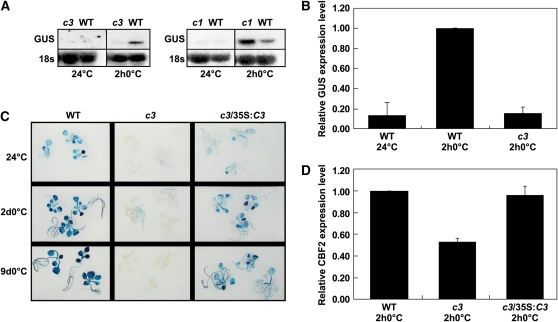Figure 5.
Effect of the camta3 Mutation on Cold-Induced Expression of the 27-bp:GUS Reporter Gene.
(A) RNA gel blot analysis determining the transcript levels of GUS in wild-type plants, camta3 plants (c3), or camta1 plants (c1) transformed with the 27-bp:GUS reporter gene, grown at 24°C, and then cold treated for 2 h at 0°C. The same blots were probed for 18s rRNA as a loading control.
(B) qRT-PCR analysis determining the transcript levels of the 27-bp:GUS reporter gene in either wild-type plants or camta3 plants (c3) grown at 24°C and then cold treated for 2 h at 0°C (2 h0°C). Relative expression level of GUS transcripts with the wild-type cold-treated plants was set to 1. Error bars indicate se. The average GUS transcript levels in the camta3 background at 0°C for 2 h were significantly different from wild-type plants at 0°C for 2 h (P value < 0.0001; n = 2 for the wild type at 24°C, n = 6 for the wild type at 0°C for 2 h, and n = 6 for camta3 at 0°C for 2 h).
(C) Histochemical staining determining GUS activity in plants carrying the 27-bp:GUS reporter gene. Seedlings tested were wild-type, camta3 (c3) plants, and camta3 plants transformed with 35S:CAMTA3 (c3/35S:C3). Plants were grown at 24°C and then cold treated at 0°C for 2 d (2d0°C) or 9 d (9d0°C).
(D) qRT-PCR analysis of CBF2 transcript levels in wild-type plants, camta3 plants (c3), and camta3 plants transformed with the 35S:CAMTA3 transgene (c3/35S:C3). Plants were grown at 24°C and then cold treated at 0°C for 2 h (2 h0°C). Error bars indicate se (n = 3).

